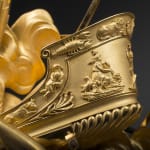Claude Galle
Further images
Literature
Tardy, "Les Plus Belles Pendules Français", 1994, p. 275, illustrating a very similar case in L'Ecole d'Horogerie de Dreux. There is another similar clock in one of the reception rooms of the Elysée Palace, Paris. Elke Niehüser, "Die Französische Bronzeuhr, Eine Typologie der Figürlichen Darstellungen" 1997, p. 60, illustrating an almost identical clock in the Bibliotheque Nationale, Paris.
A magnificent and very rare Empire gilt bronze and marble figural clock, signed on the white enamel dial by the clockmaker Thomas à Paris and also signed on the dial by the bronzier Galle (1759-1815).
The fantastic case representing the fall of Phaeton
Paris, date circa 1805
Height 70 cm
The story of Phaeton lent itself so well as a subject for figural clocks and is perfectly captured this wonderful sculptural case by the great bronzier Claude Galle. Accrording to mythology Phaeton the son of Helios, the sun god persuaded his unwilling father to let him drive his golden chariot across the skies. Ovid tells how the hours or Horae harnessed the four horses to the chariot, then Dawn or Aurora opened her doors and Phaeton drove upward. But having no experience he was helpless when he met the fearful Scorpion of the zodiac (the Scorpion with other signs of the zodiac appears on the chariot itself). Phaeton dropped the reins, his horses bolted and the Earth began to catch on fire.
However Jupiter arrested the situation, sending a thunder bolt to the wreck the chariot and Phaeton went tumbling down in flames into the River Eridanus. The main story is begun and continued on the gilded frieze below. Phaeton's fate is portrayed in the central panel, which shows how after the nymphs had buried him, Phaeton's mother, Clymene and his sisters, the Heliads mourned over his grave. As his sisters wept they were turned into poplar trees and their tears were turned to amber beads. Cygnus, a friend of Phaeton also came to mourn, and as he did he was turned into a swan.
The case is complemented by the clock itself, which was made by the Parisian clockmaker Nicolas Thomas (d. after 1806). He became a maître-horloger in 1778 and in the same year was appointed Horloger du Roi, supplying clocks to the King Louis XVI. He was established at Rue du Bac circa 1781-83, at Rue de l'Echelle circa 1787-89 and by 1806 at Rue de Gretry.
He married Thérèse, daughter of Pierre Millot, another very fine clockmaker.







